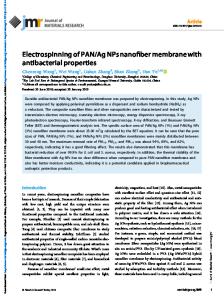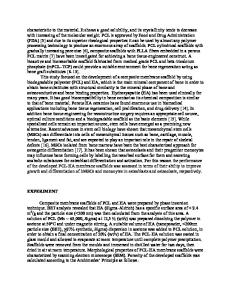Waterproof and breathable polyacrylonitrile/(polyurethane/fluorinated-silica) composite nanofiber membrane via side-by-s
- PDF / 1,076,665 Bytes
- 9 Pages / 584.957 x 782.986 pts Page_size
- 33 Downloads / 255 Views
Waterproof and breathable polyacrylonitrile/ (polyurethane/fluorinated-silica) composite nanofiber membrane via side-by-side electrospinning Yunge Yu1, Fuli Zhang2, Yan Liu1,a), Yuansheng Zheng3, Binjie Xin3,b) Xiaoxiao Peng1, Shixin Jin4
, Zhenlin Jiang1,
1
School of Chemistry and Chemical Engineering, Shanghai University of Engineering Science, Shanghai 201620, China The Naval Medical I Research Institute, Naval Medical Research Institute, Shanghai 200433, China School of Textiles and Fashion, Shanghai University of Engineering Science, Shanghai 201620, China 4 Institute of Textiles and Clothing, The Hong Kong Polytechnic University, Kowloon, Hong Kong 999077, China a) Address all correspondence to these authors. e-mail: [email protected] b) e-mail: [email protected] 2 3
Received: 18 September 2019; accepted: 31 March 2020
Electrospun membranes have potential applications in the field of waterproof and breathable textile products. However, challenges still exist to improve the breathability, and waterproof and mechanical properties of these microporous membranes. In this paper, a novel hydrophobic microporous nanofiber membrane was prepared via side-by-side electrospinning of fluorosilane-modified silica nanoparticles (F–SiO2) blended with synthesized polyurethane (PU) solution and composited with the polyacrylonitrile (PAN) solution. To prepare F–SiO2, SiO2 nanoparticles were hydrophobically modified by fluorosilane. Composite nanofiber membranes with different blending ratios of PU(F–SiO2)/PAN were fabricated via side-by-side electrospinning by controlling the extruding speed of two spinnerets. Experimental results indicated that regarding F–SiO2 as hydrophobic inorganic particle can improve the hydrophobic properties of PU nanofiber membrane. The prepared PAN/(F–SiO2/PU) nanofiber microporous membranes exhibit relatively excellent waterproof and mechanical properties as that robust tensile strength (19.5 MPa), preferable water vapor permeability [10.3 kg/(m2 d)], favorable water contact angle (137.2°), and superior mechanical properties. It was believed that the reinforced PAN/(F–SiO2/PU) nanofibrous composite membranes have potential applications in chemical protective clothing, army combat uniforms, selfcleaning materials, and other medical products.
Introduction The waterproof and breathable microporous membrane can be used in extreme climates, such as a snowstorm or a rainstorm, owning to outstanding wearable comfort performances and the ability of blocking water penetration and permitting vapor transmission. As of today, it has been successfully applied in a broad range of industrial fields, such as protective clothing, outdoor protection devices, medical protection, and sportswear products [1, 2, 3, 4]. In recent years, many strategies have been proposed to develop various waterproof and breathable membrane materials. Existing membranes can be divided into two categories: the hydrophilic nonporous membrane without pore structure,
ª Materials Research Society 2020
which can be used only in the higher humid
Data Loading...











